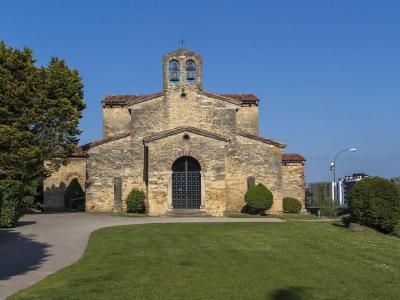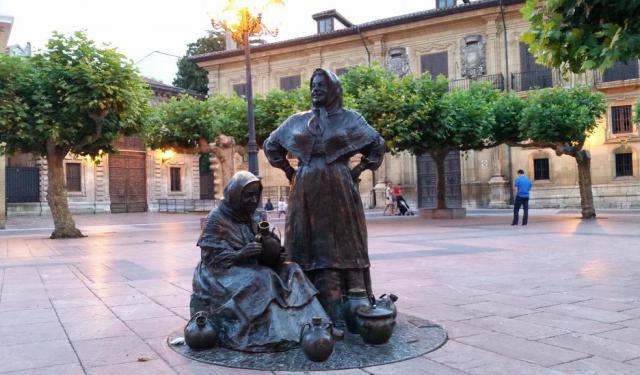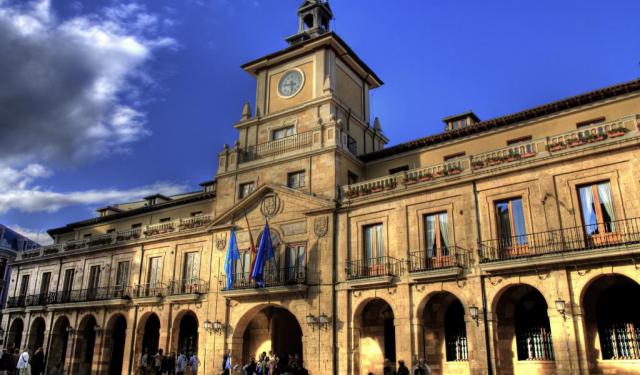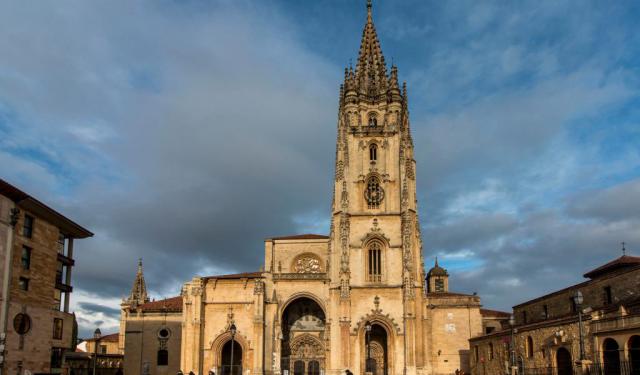San Julián de los Prados Church, Oviedo
Saint Julian of the Fields Church is one of the standout monuments of Asturian pre-Romanesque art. Built in the early 9th century under King Alfonso II, the church preserves a spacious basilican plan with three naves and a broad transept, giving the exterior its stepped roofline and sturdy, stone-walled profile. It forms part of the UNESCO listing “Monuments of Oviedo and the Kingdom of the Asturias,” recognized for their exceptional early medieval architecture.
What makes the church unique is its interior painting. Large portions of the walls still carry ninth-century frescoes: geometric bands, painted arcades, draperies, and architectural motifs that recall Roman and late-antique models. Strikingly, the program is aniconic-there are no human or divine figures-so the effect is atmospheric rather than narrative, enveloping the space in patterned colour and imagined architecture. These are among the best-preserved early medieval murals on the Iberian Peninsula.
From the lawned forecourt, you enter a calm, dim interior where the painted surfaces and thick piers create a sense of quiet continuity with the early 800s. The plan is easy to read: low side aisles flanking the higher central nave, the transverse arm opening like a crossbar, and three straight-ended chapels at the east. Even without sculpture or stained glass, the play of painted ornament gives the church its character.
San Julián de los Prados is an active parish, so access can vary around services. If you’re planning a look inside, check the posted times on the parish site and avoid Mass hours.
What makes the church unique is its interior painting. Large portions of the walls still carry ninth-century frescoes: geometric bands, painted arcades, draperies, and architectural motifs that recall Roman and late-antique models. Strikingly, the program is aniconic-there are no human or divine figures-so the effect is atmospheric rather than narrative, enveloping the space in patterned colour and imagined architecture. These are among the best-preserved early medieval murals on the Iberian Peninsula.
From the lawned forecourt, you enter a calm, dim interior where the painted surfaces and thick piers create a sense of quiet continuity with the early 800s. The plan is easy to read: low side aisles flanking the higher central nave, the transverse arm opening like a crossbar, and three straight-ended chapels at the east. Even without sculpture or stained glass, the play of painted ornament gives the church its character.
San Julián de los Prados is an active parish, so access can vary around services. If you’re planning a look inside, check the posted times on the parish site and avoid Mass hours.
Want to visit this sight? Check out these Self-Guided Walking Tours in Oviedo. Alternatively, you can download the mobile app "GPSmyCity: Walks in 1K+ Cities" from Apple App Store or Google Play Store. The app turns your mobile device to a personal tour guide and it works offline, so no data plan is needed when traveling abroad.
San Julián de los Prados Church on Map
Sight Name: San Julián de los Prados Church
Sight Location: Oviedo, Spain (See walking tours in Oviedo)
Sight Type: Religious
Guide(s) Containing This Sight:
Sight Location: Oviedo, Spain (See walking tours in Oviedo)
Sight Type: Religious
Guide(s) Containing This Sight:
Walking Tours in Oviedo, Spain
Create Your Own Walk in Oviedo
Creating your own self-guided walk in Oviedo is easy and fun. Choose the city attractions that you want to see and a walk route map will be created just for you. You can even set your hotel as the start point of the walk.
Oviedo Public Art Walking Tour
Public art adds a great deal of vibrancy and character to the cityscape of Oviedo, Spain, reflecting, among other things, its contemporary spirit. From the bustling Plaza Trascorrales to the serene Plaza Porlier De Oviedo, numerous sculptures have long become an integral part of the neighborhood, captivating passers-by in their numbers.
In Plaza Trascorrales, sculptures like The Fishwife and... view more
Tour Duration: 3 Hour(s)
Travel Distance: 3.0 Km or 1.9 Miles
In Plaza Trascorrales, sculptures like The Fishwife and... view more
Tour Duration: 3 Hour(s)
Travel Distance: 3.0 Km or 1.9 Miles
Oviedo Historic Architecture
The north Spanish region of Asturias and particularly its capital city, Oviedo, have long been noted for their unique architecture. The medieval part of town, whose ancient walls are still largely intact, contains some truly priceless relics. Among them is a well called La Foncalada, a fascinating example of an effective hydraulic system, dating back to the first half of the 9th century, based on... view more
Tour Duration: 2 Hour(s)
Travel Distance: 2.7 Km or 1.7 Miles
Tour Duration: 2 Hour(s)
Travel Distance: 2.7 Km or 1.7 Miles
Oviedo Introduction Walking Tour
The Kingdom of Asturias began in 720, with the Visigothic revolt against Muslim rule led by the nobleman Pelagius. At that time, the city of Oviedo did not exist. Two monks, Maximo and Fromestano, founded the city in 761. They built a small church for Saint Vincent on a bare hillside, and from this seed, Oviedo grew.
After Pelagius died in 737, King Alfonso I founded a dynasty in Oviedo that... view more
Tour Duration: 1 Hour(s)
Travel Distance: 1.8 Km or 1.1 Miles
After Pelagius died in 737, King Alfonso I founded a dynasty in Oviedo that... view more
Tour Duration: 1 Hour(s)
Travel Distance: 1.8 Km or 1.1 Miles






